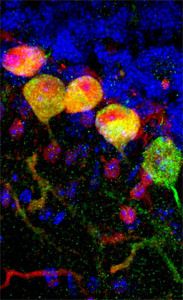Autophagy, the process by which cells recycle damaged components, has long been associated with neuroprotection. However, the precise mechanisms by which autophagy maintains brain health have remained elusive. A team of researchers led by Professor Dr Natalia Kononenko at the CECAD Cluster of Excellence for Aging Research, in collaboration with other institutions at the University of Cologne, Forschungszentrum Jülich and University of Lausanne has uncovered that autophagy via its crucial player ATG5 ensures neuronal survival by regulating the glucose metabolism in the brain. The discovery was published in Nature Metabolism under the title ‘Autophagy regulator ATG5 preserves cerebellar function by safeguarding its glycolytic activity’.
The study, which was conducted within the framework of the Collaborative Research Centre 1451 ‘Key Mechanisms of Motor Control in Health and Disease’, highlights the pivotal role of autophagy player ATG5 in Purkinje cells – neurons essential for motor coordination. Beyond its established function of recycling cellular waste, ATG5 prevents the excessive accumulation of glucose transporter 2 (GLUT2) on the cell surface during brain development. This regulation keeps glycolysis, the process by which cells convert glucose into energy, in Purkinje cells low, thereby protecting them from metabolic imbalances.
The scientists found this mechanism by using advances techniques such as PET imaging, multi-omics and 3D kinematics and investigating mice lacking ATG5. As a result, GLUT2 accumulated, which led to heightened glucose uptake, altered glycolytic activity and the production of toxic metabolic by-products. These disruptions ultimately resulted in Purkinje cell death and motor gait dysfunction, underscoring the critical role of autophagy in maintaining cerebellar health.
‘Our research demonstrates that autophagy isn’t just about clearing damaged mitochondria or protein aggregates,’ explained first author Dr Janine Tutas. ‘In Purkinje cells, ATG5 actively regulates metabolic pathways to prevent cell death.’
Professor Dr Natalia Kononenko added: ‘These findings highlight the sophisticated ways autophagy supports neuronal health beyond its traditional roles.’ According to the researchers, understanding these mechanisms provides a clearer picture of how the brain combats neurodegeneration, opening up new possibilities to treat conditions like Parkinson’s and Alzheimer’s diseases, where both metabolic and autophagic dysfunctions are common. While this mechanism has so far only been shown in mice, further studies will investigate how autophagy regulates metabolism in both mouse and human-based models of neurodegenerative diseases.
Media Contact:
Professor Dr Natalia Kononenko
CECAD Cluster of Excellence for Aging Research
+49 221 478 84261
n.kononenkouni-koeln.de
Press and Communications:
Dr Anna Euteneuer
+49 221 470 1700
a.euteneuerverw.uni-koeln.de
Publication:
https://www.nature.com/articles/s42255-024-01196-4
Further information:
CECAD Cluster of Excellence in Aging Research
